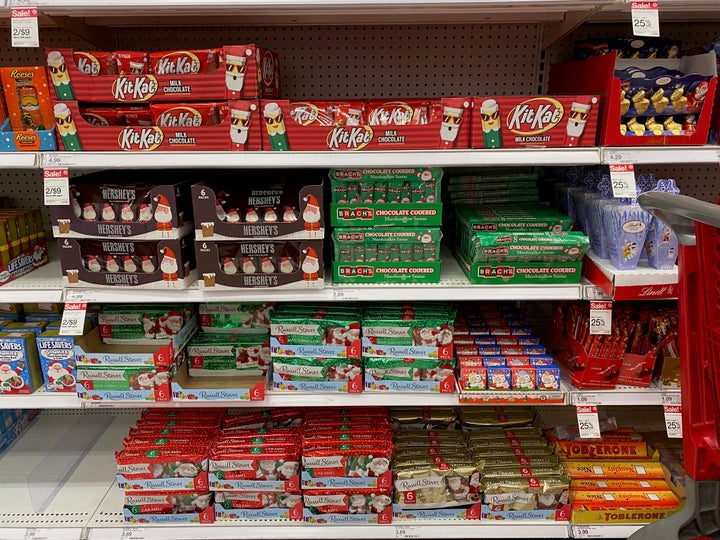My daughter loves Christmas, so when she wasn’t feeling well recently I looked for a small gift for her in the holiday section at Target. I went for a stuffed animal: the arctic fox from the Elf on the Shelf. Box in hand, I peered at the included picture book, which featured Santa. A white Santa. I’d already passed hand towels and pillows I couldn’t buy because they only featured white Santas and white elves. Same thing happened in the candy aisle — even the chocolate Santas came wrapped in white-Santa foil. I put the stuffed animal back on the shelf.
Last year, at age four, my daughter was indignant when we brought out the brown Santa we’d had since her first Christmas.
“Santa is white,” she insisted, amazed at our ignorance and our refusal to acknowledge such a clear truth.
“Why do you think Santa is white?” I asked.
“Because he is,” she answered. For weeks, she pointed out examples of white Santas, from the movie The Polar Express to the local sit-on-Santa’s-lap events. “See?” she’d say petulantly. “I told you Santa is white.”
My wife and I are devoted to surrounding our daughter with positive images of brown and Black people. My wife is a sociologist, and I’m a onetime literary historian. She’s Black and Jewish, and I’m Puerto Rican and Irish. Our daughter is Native American and African American. Professionally and personally, we know something about race in the US, and have read extensively about the best way to help our kid deal with racism.
Still, American cultural institutions are slowly defeating us. Despite recent corporate pledges to the idea that Black lives matter, simple changes like better representation of diversity on store shelves haven’t happened.
More than 65 years after the Supreme Court case Brown vs. the Board of Education made the “doll test” famous, I still can’t walk into a superstore and find BIPOC really represented in toys.
My daughter’s instance on Santa’s whiteness is disturbing for what it represents: that the world is thwarting my efforts to create a space for my daughter where people of colour are front and centre. Our culture continues to insist that BIPOC are secondary ― and, all too often, completely invisible.

It’s not just Santa. When we go to the store to buy a Chelsea doll, we can only find the white, blonde version. The Polly Pocket toys on the shelf come with the two white characters included; their Black friend Shani is available only in a jungle-themed house. Shopping is painful year-round, but especially during the holiday season.
What my daughter sees around her matters to how she understands herself. Studies suggest that just seeing a teacher of colour leading their class, for instance, has a positive impact on kids. A child’s relationship with Santa is very different from their connection to their teacher, but it’s still powerful. Santa is a mythical man who sees and judges your every action. He withholds and rewards a child’s most dearly held wishes. And white America isn’t ready to see a Black person in a such a role.
When the Mall of America cast a Black man as Santa in 2016, a fiercely racist online backlash followed. The prevailing view at the time was that the online racism was an anomaly. Today, it seems predictive of how open racism would become in the U.S. in the ensuing years.
“I’m glad we have methods to mitigate the effects of living in a racist society. But my daughter’s life — and mine, too — would be so much easier if consumers of all races demanded diversity in stores.”
“Our kids are more exposed than we think and the larger environment can be pretty toxic in these ways,” Melissa Giraud, co-founder of the organisation Embrace Race, said when I asked her for advice. Embrace Race’s goals include building resilience in children of colour and teaching empathy to all children.
Giraud noted that our efforts to provide our child with spaces where people of colour were central were countercultural efforts, and that pushing back against mainstream culture is an ongoing challenge. “We have to keep going,” she said, “and they have to work through their ideas about this stuff.”
This wildly uneven tug-of-war with racism is exhausting. But the best thing parents can do is continually meet issues of racism head-on, explained Medina Jackson, the director of engagement for P.R.I.D.E at the University of Pittsburgh, a program that develops positive racial identity in Black children.
“The first thing you want to do is not shush them,” Jackson told me. Next, parents should monitor their own reaction and remain calm, which is harder than it sounds when something disturbing happens (like your daughter rejecting Black Santa). Then talk to them about whatever issue they bring up. If you can’t do it in the moment, set a date to talk later — and make sure you keep the date.
I’m glad we have methods to mitigate the effects of living in a racist society. But my daughter’s life — and mine, too — would be so much easier if consumers of all races demanded diversity in stores, and if stores agreed to do the right thing by showing that Black and brown lives matter in the products they feature.
Since it’s Christmas, I’ll hold out hope that someday this will happen, and that this holiday my daughter loves so much will be less white.
This article first appeared on HuffPost Personal
Have a compelling personal story you want to tell? Find out what we’re looking for here, and pitch us on ukpersonal@huffpost.com
